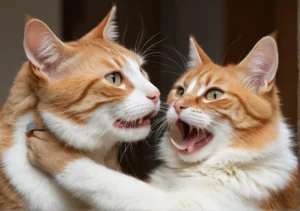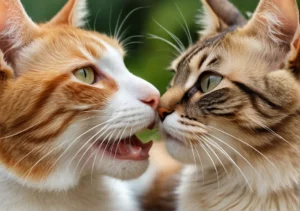Cats are mysterious creatures, known for their unpredictable behavior. One moment they are happily purring in your lap, and the next they may attack you seemingly out of nowhere. But why do cats attack while purring? Let’s explore this puzzling phenomenon further.
Have you ever wondered why your cat sometimes turns aggressive while in the midst of contented purring? The answer lies in the complex nature of feline communication. Cats use purring not only to show happiness and contentment but also as a means of self-soothing in stressful situations. When a cat becomes overstimulated or feels threatened, their purring can shift from a sign of relaxation to a warning signal. This can result in aggressive behavior, such as biting or scratching, as a way for the cat to defend themselves.
Understanding Feline Communication
Have you ever wondered how cats communicate with us? Well, they do it in more ways than just meowing! Cats use a combination of body language, vocalizations, and behaviors to express themselves. Purring is often associated with contentment and relaxation, but it can also be a sign of other emotions, such as stress or anxiety.
When a cat is purring, pay attention to their body language. Are their ears flat against their head? Is their tail flicking back and forth rapidly? These could be signs that your feline friend is feeling overwhelmed or overstimulated. Understanding these subtle cues can help you decipher what your cat is trying to communicate.
If your cat is purring loudly but also showing signs of agitation, it’s important to give them some space and respect their boundaries. Sometimes, cats may lash out in the form of play aggression when they are feeling overwhelmed. By recognizing the signs of overstimulation, you can prevent a potential attack and ensure a safe and happy environment for both you and your furry companion.
Signs of Overstimulation in Cats
Cats are incredible creatures, but they have their limits too. When it comes to overstimulation, our feline friends can quickly go from purring sweetly to attacking unexpectedly. Keep an eye out for common signs that indicate your cat is reaching their breaking point.
- Tail Lashing: If you notice your cat’s tail swishing back and forth rapidly, it could be a sign of agitation.
- Ears Flattened: When a cat’s ears are pinned back against their head, it indicates they are feeling stressed or overwhelmed.
- Dilated Pupils: Large pupils can signal that a cat is on high alert and may be getting ready to attack.
It’s essential to respect your cat’s boundaries and provide them with the space they need when they are feeling overstimulated. By understanding these signs, you can prevent potential attacks and foster a harmonious relationship with your furry friend. If you notice these behaviors consistently, consider consulting with a veterinarian or animal behaviorist for further guidance.
Triggers for Aggressive Behavior in Cats
Have you ever wondered why your cat can go from purring contentedly to suddenly attacking? It can be surprising and concerning, but understanding the triggers for aggressive behavior in cats can help you manage these situations better.
One common trigger is environmental stressors. Changes in the home environment, such as new pets, visitors, or loud noises, can make cats feel anxious or threatened, leading to aggression. Past experiences, like trauma or negative interactions, can also contribute to aggressive behavior in cats.
To address this, create a safe and comfortable space for your cat where they can retreat when feeling overwhelmed. Avoid forcing interactions and respect their boundaries to prevent triggering aggressive behavior. Providing environmental enrichment, such as scratching posts and interactive toys, can also help reduce stress and redirect their energy in a positive way.
Remember, aggression in cats is often a response to feeling scared or threatened, so approach with patience and empathy. By understanding the triggers and creating a calming environment, you can help your cat feel more secure and less likely to lash out.
How to Safely Handle an Aggressive Cat
Handling an aggressive cat requires patience and understanding to ensure both your safety and the well-being of your feline friend. If your cat is displaying aggressive behavior while purring, it’s essential to approach the situation with caution.
When faced with an aggressive cat, avoid making sudden movements or loud noises that can escalate the situation. Instead, give them space and time to calm down. Use gentle and soothing tones to communicate with your cat, reassuring them that they are safe.
If you need to handle an aggressive cat, use protective gear like thick gloves or a blanket to shield yourself from scratches or bites. Approach them slowly and calmly, avoiding direct eye contact, and give them the opportunity to retreat if they feel threatened.
Remember, never punish your cat for being aggressive as it can worsen their behavior. Instead, seek professional help from a veterinarian or animal behaviorist to address underlying issues causing aggression. With patience, consistency, and respect for your cat’s boundaries, you can safely handle their aggressive behavior and build a trusting relationship.
Additional Tip: Redirect your cat’s energy by engaging them in interactive play sessions with toys that mimic hunting behaviors. This can help release pent-up energy and reduce the likelihood of aggressive outbursts.
Redirecting Aggression in Cats
When your cat attacks while purring, it can be a confusing and challenging situation to handle. One effective way to redirect your cat’s aggressive behavior is by engaging them in interactive play and enrichment activities. This helps channel their energy and predatory instincts in a positive and stimulating manner. Interactive toys like feather wands, laser pointers, and puzzle feeders are great options to keep your cat mentally and physically engaged. By providing these outlets for your cat’s natural behaviors, you can help reduce the likelihood of them lashing out aggressively. Remember, a tired cat is a happy cat!
Seeking Professional Help
If your cat’s aggressive tendencies persist despite your efforts to redirect their behavior, it may be time to seek assistance from a professional, such as a veterinarian or animal behaviorist. A veterinarian can rule out any underlying medical issues that may be causing or contributing to your cat’s aggression. An animal behaviorist can help identify the root cause of the aggression and develop a tailored behavior modification plan to address it effectively. Seeking professional help is crucial in ensuring the well-being of your cat and creating a harmonious environment for both you and your feline companion.
Tips for Preventing Aggression in Cats
If you’re wondering why your cat sometimes attacks while purring, there are a few things you can do to prevent this behavior. First and foremost, provide plenty of opportunities for play and exercise. Cats need mental and physical stimulation to stay happy and healthy, so make sure they have plenty of toys and interactive playtime.
Additionally, create a safe and comfortable environment for your cat. Make sure they have a quiet place to retreat to when they need some alone time, and provide plenty of hiding spots and elevated perches for them to survey their surroundings. This can help reduce stress and prevent aggressive behavior.
Regular veterinary check-ups are also essential to rule out any underlying medical issues that may be causing your cat to act aggressively. Sometimes, aggression can be a sign of pain or discomfort, so it’s crucial to address any health concerns promptly.
Lastly, never punish your cat for aggressive behavior. This can escalate the situation and make the problem worse. Instead, try to understand what triggers your cat’s aggression and work on modifying their environment or routine to reduce these triggers.
By taking these proactive measures, you can help prevent aggression in your cat and maintain a peaceful relationship with your feline friend.
Fun Facts About Cat Behavior
Did you know that cats purr not only when they’re happy, but also when they’re anxious or in pain? Purring is a versatile form of communication for cats and can have different meanings depending on the context.
One interesting fact about cat behavior is that cats may attack while purring as a form of redirected aggression. This occurs when a cat is agitated or overstimulated by something in their environment, but they redirect that frustration onto a nearby person or animal, even while purring to self-soothe.
Another fun fact is that cats have scent glands on their cheeks and paws, which they use to mark their territory and communicate with other cats. So, when your cat is purring and rubbing against you, they are not only showing affection but also claiming you as their own.
Understanding these fascinating aspects of cat behavior can give you insight into why your feline friend may exhibit certain behaviors, like attacking while purring. Remember, each cat is unique, so observing and respecting their individual quirks is key to nurturing a harmonious relationship.
Alex, a passionate animal lover, has experience in training and understanding animal behavior. As a proud pet parent to two dogs and three cats, he founded AnimalReport.net to share insights from animal experts and expand his knowledge of the animal kingdom.




